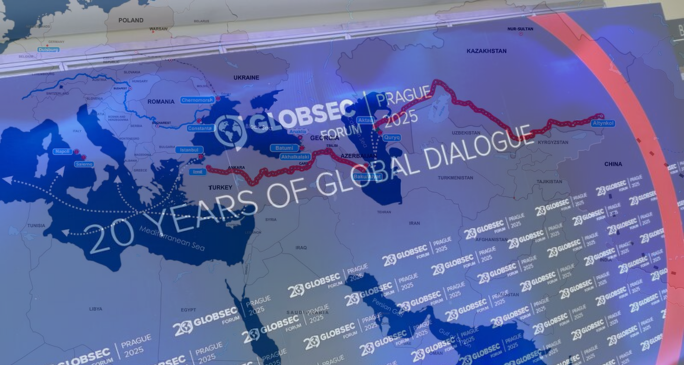|
|
TODAY.AZ / Analytics
Azerbaijan’s strategic vision turns transit route Into global opportunity
16 June 2025 [08:30] - TODAY.AZ

As the global order adjusts to shifting centers of power and rising geopolitical fragmentation, connectivity is no longer a matter of convenience - it is a matter of strategic foresight. The Middle Corridor, stretching across Central Asia, the Caspian Sea, and the South Caucasus into Europe, represents not just a new transit route, but a new vision for East-West cooperation. In the words of Hikmet Hajiyev, Assistant to the President of Azerbaijan, “No one should think this corridor is non-existent or in need of reconstruction. Azerbaijan and our partners are investing in it. New partners are welcome to take advantage of these opportunities.”
This is not mere rhetoric. The corridor, also known as the Trans-Caspian International Transport Route, is already operational and increasingly important as global supply chains seek alternatives to the Northern Corridor through Russia or the maritime routes exposed to bottlenecks and instability. What distinguishes the Middle Corridor is not only its geographic practicality but the political will behind it. Azerbaijan is not waiting for others to act; it is actively building and investing alongside regional and international partners.
At the heart of Azerbaijan’s strategic approach is the recognition that connectivity must transcend competition. Trade between the European Union and China, two of the world’s largest economic blocs, exceeds 700 billion euros annually. Rather than framing this relationship as a zero-sum game, Azerbaijan sees potential in bridging the two. “They may compete,” Hajiyev observed during the GLOBSEC Forum in Prague, “but we see this as an opportunity for cooperation.” This is more than diplomacy—it is a clear-eyed assessment of how interdependence can become infrastructure.
The corridor itself is not a promise—it is a reality. Ports have been modernized on the Caspian coast. Rail infrastructure linking Baku to Kars in Turkey has been enhanced. Customs harmonization across borders is being implemented. This network enables goods to move efficiently from China through Central Asia, across the Caspian Sea to Azerbaijan, and onward to Europe via Turkey. In a world where time equals competitiveness, the Middle Corridor shortens not just physical distances but the strategic gap between East and West.
Yet, the long-term success of the Middle Corridor depends not only on steel and stone, but on the willingness of other nations and corporations to invest in its promise. Hajiyev’s invitation—"New partners are welcome to take advantage of these opportunities"—is a clear signal. This is a corridor open not just in function, but in vision. It is not controlled by a single hegemon. It is shaped by cooperation.
The interplay between China’s Belt and Road Initiative and the European Union’s Global Gateway initiative remains an open question, especially in regions like the South Caucasus and the Caspian Basin. But rather than waiting for answers to emerge, Azerbaijan is building its own. “We are open to cooperation with our partners,” Hajiyev noted, “but we are also carrying out our own plans.” This kind of agency—strategic but inclusive—is what defines the new geopolitics of connectivity.
There will always be skeptics. Some will argue that regional tensions or logistical constraints may limit the corridor’s potential. But such skepticism often underestimates the power of aligned interests. When trade, geography, and diplomacy converge, what emerges is more than a corridor—it is a channel for trust, growth, and mutual benefit.
In the end, the Middle Corridor is not simply a route. It is a statement: that regional players can act globally, that infrastructure can be diplomacy, and that Azerbaijan is ready, not just to host a corridor, but to lead it.
URL: http://www.today.az/news/analytics/259893.html
 Print version
Print version
Connect with us. Get latest news and updates.
See Also
- 19 October 2025 [15:23]
Reconstruction in Garabagh reshapes balance of power in Caucasus - 17 October 2025 [13:59]
Baku-Paris enter new diplomatic chapter as past misunderstandings fade - 16 October 2025 [17:44]
Washington relies on Azerbaijan, Pakistan and Indonesia to stabilise Gaza - 16 October 2025 [14:01]
Azerbaijan steps onto Middle East stage to bridge new frontiers of peace - 15 October 2025 [19:58]
Congress, ANCA, and fragile peace in South Caucasus [Op-Ed] - 13 October 2025 [19:45]
Afghanistan-Pakistan clashes leave scores dead amid rising tensions - 13 October 2025 [08:30]
Between Washington and Middle East, Azerbaijan’s role gains new weight - 10 October 2025 [13:43]
Baku's strategic diplomacy shines at CIS Summit in Dushanbe - 10 October 2025 [08:30]
Why FinTech matters: Unlocking economic growth and financial inclusion in Azerbaijan - 09 October 2025 [13:27]
Ocampo’s double standards: silence on war crimes, loud on bias
Most Popular
 Iran makes up for lost time: waiting for the Araz Corridor
Iran makes up for lost time: waiting for the Araz Corridor
 Carpet Museum director holds series of meetings in United States
Carpet Museum director holds series of meetings in United States
 Baku-Paris enter new diplomatic chapter as past misunderstandings fade
Baku-Paris enter new diplomatic chapter as past misunderstandings fade
 CBA and World Bank discuss expanding long-term cooperation on sustainable development
CBA and World Bank discuss expanding long-term cooperation on sustainable development
 Over past decades, brotherly nations Azerbaijan and Kazakhstan built relations of genuine strategic and allied partnership - President Ilham Aliyev
Over past decades, brotherly nations Azerbaijan and Kazakhstan built relations of genuine strategic and allied partnership - President Ilham Aliyev
 Baku, Tabriz discuss sister city partnership and cooperation in Garabagh reconstruction
Baku, Tabriz discuss sister city partnership and cooperation in Garabagh reconstruction
 Turkmenistan Culture Days wraps up in Ganja
Turkmenistan Culture Days wraps up in Ganja
